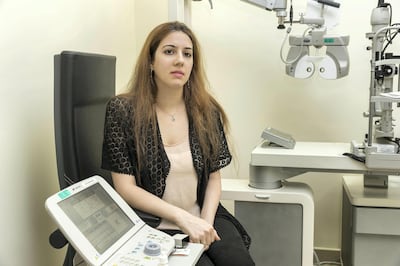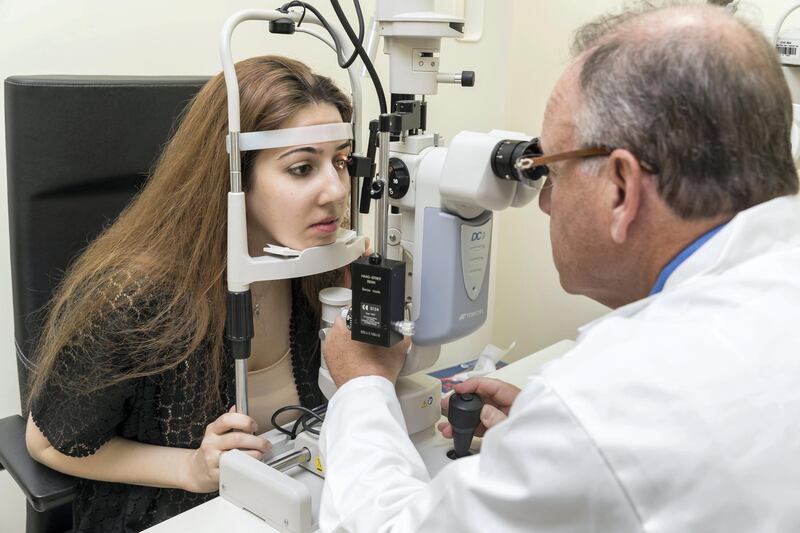An innovative therapy for blindness that is attributed with restoring some sight in people with previously untreatable vision loss is being offered in Dubai. The procedure, called bone marrow fraction therapy, was developed by Dr Jeffrey Weiss, a retinal surgeon based in Florida in the US.
In the experimental procedure, Dr Weiss takes stem cells from the patient’s own bone marrow and injects those cells directly into the eye. He has treated 530 patients in his Florida office since 2012. With the help of the Dubai Health Authority, he is now treating patients in Dubai.
Three to four times a year, Dr Weiss flies to the emirate - bringing all the medical equipment he needs to do the surgeries – and offers the treatment to patients at Al Zahra Hospital. He’s treated 15 to 20 patients in the city since 2015.
Dr Weiss, who is the former chief of retinal surgery at the Joslin Diabetes Centre in Boston as well as a former faculty member of Harvard Medical School, is passionate about the potential to give back at least some vision to people who have no other options.
“I am only treating people with untreatable conditions – those with long-standing chronic, progressive blinding conditions for which there is no treatment. I became a physician to treat untreatable conditions, to push the envelope. To make discoveries,” he said.
It takes four teams of people working simultaneously at Al Zahra Hospital to deliver Dr Weiss’s treatment. It starts by taking a bone marrow sample from the patient’s hip bone. A centrifuge then separates the stem cells from that sample. Those cells are then injected into and around the damaged parts of the eye in a surgery that takes less than an hour. “Typically, we wind up injecting over a billion stem cells,” said Dr Weiss.
_______________
Read more:
[ Blindness could be avoided in most cases – so why isn’t it? ]
[ Dubai charity's vision to combat blindness in UAE and beyond ]
[ Enlightened vision to restore sight ]
_______________
Once those stem cells are injected, they go to work repairing tissue. Stem cells are immature cells that can turn into helpful, specialised cells. Dr Weiss said it is important to point out that the cells used in this treatment come from the patients themselves.
“There’s tremendous bias politically because when people hear the word stem cell, they automatically think that [they come from embryos],” he said. “The stem cells in this treatment are autologous stem cells. They come from the patient. These are your stem cells.”
Adult stem cells like these have been used for years to successfully treat leukaemia and bone and blood cancers.
It is difficult to predict how much vision will be restored in each patient; and for some patients, it’s possible it may not help at all, said Dr Weiss. Why the treatment appears to work is not understood, nor why it helps some patients but not others. There have been no clinical trials of the procedure.
Depending on the condition – and on how bad their vision is before treatment – patients may see improvement within four to six months. Some patients notice an improvement within days. In the past, Dr Weiss has claimed some improvement in the sight of around 60 per cent of his patients, which also means that four out of ten see no benefit.
Dana Nashawati, a 30-year-old Syrian who has lived in Dubai her entire life, developed a viral infection in her optic nerve after a bout with the flu. She lost vision in her left eye first. Nine months later, she lost it in her right eye. She was 13 years old. Ms Nashawati finished grade nine by taking tests orally.

After that, she lost hope for any chance at a normal life.
“I stayed at home for almost four years,” she said.
“It was my denial stage. I couldn’t see my hand in front of me but still I was in denial. I didn’t accept it. I didn’t want to believe it.”
She eventually found help through Tamkeen, a centre for the visually-impaired in Dubai.
“When I entered the centre, I saw people who were all well-educated. They either studied, or they were working, or they were married with families. I realised I was missing out on things,” she said.
Ms Nashawati used that inspiration to earn a bachelor’s degree from the Canadian University Dubai and a master’s degree from the University of Wollongong in Dubai.
She earned both degrees while simultaneously working at Emirates Airlines, where she is now a human resource coordinator.
Even after finding success in life without her vision, Ms Nashawati held onto hope that she would one day see again. When a family member told her about Dr Weiss’s treatment, she did not hesitate.
“I was hoping for any improvement,” she said.
“I can do most things myself, but my aim is to walk independently. This is my goal.”
Four months after her first surgery in 2015, Ms Nashawati began to see things she couldn’t see before.
In May, she had the procedure again to see if she could get even more improvement. Before the surgeries, she could only see 30cm in front of her face. Now she can see nearly three metres in front of her.
“I can see things around me better,” she said.
“Obstacles are clearer. I can move around the office better without bumping into desks and people. I can see colour now and count fingers. If a door is half-open, I know it’s open and I don’t bump into it. And when someone puts their hand out to shake my hand, I can shake it. I couldn’t do that before. Maybe these things sound minor, but for me, these make a big difference.”
Ms Nashawati got married last week and planned every detail of her wedding herself.
“My case was classified by my previous doctors as a helpless case,” she said. “They said ‘Don’t even bother to try. There is no way out.’ These surgeries have given me hope.”
Dr Weiss said bringing hope to patients halfway across the world has been a challenge, but Dubai Health Authority, who he has worked closely with in getting this treatment to Dubai, has been “very receptive in helping their people.”
However, the treatment does not come cheap and is not covered by insurance. The surgery costs about $30,000 (Dh120,200), which includes all pre- and post-op visits and medication. The surgery is currently being studied in retinal and optic nerve diseases such as retinitis pigmentosa, optic nerve atrophy, age-related macular degeneration and glaucoma.
“This is the most rewarding thing I've ever done professionally in my entire life,” said Dr Weiss. “When you treat people who have zero per cent chance of improvement and they improve, that’s a breakthrough. This is a breakthrough.”
To be considered for the treatment at Al Zahra Hospital, patients can contact study director Steve Levy at stevenlevy@mdstemcells.com.
__________
The next target?
Dr Weiss has recently launched a study on his stem cell technique for neurological conditions.
In his vision studies, not all of the patient’s stem cells are used in the eye. Any leftover stem cells are subsequently given back to the patient in an IV drip, which may result in an improvement in other conditions.
When treating patients with vision loss who also had neurological damage, Dr Weiss noticed several patients experienced an improvement in their neurological deficits too.
“We had a man who was in a wheelchair and two months after eye surgery, he advanced to a walker. We had someone who couldn’t speak after a stroke and started to speak a couple months after treatment. We had someone who lost his sense of smell in a motor vehicle accident and two days later, they started smelling. We’ve had people with hearing loss improve,” he said.
Dr Weiss’s procedure has the potential to help conditions such as Parkinson’s disease, traumatic brain injury, stroke, diabetic neuropathy and multiple sclerosis.
The neurologic stem cell treatment study, dubbed NEST, is currently only enroling patients in the US, but Dr Weiss is working with the Dubai Health Authority to bring the treatment to Dubai.
The study protocol is currently under review by the DHA.





